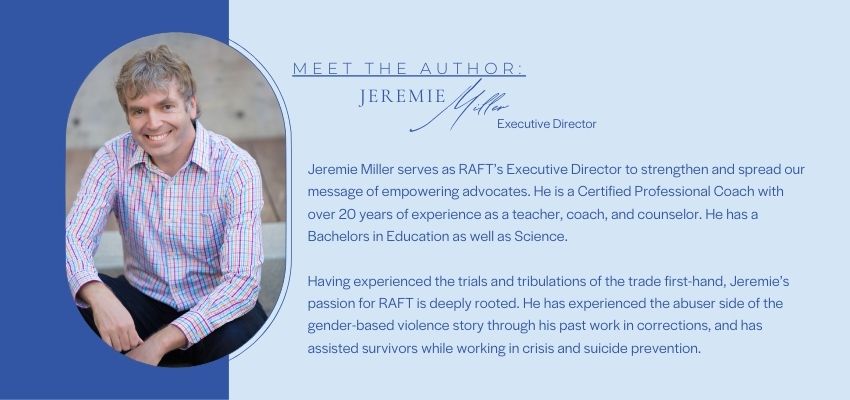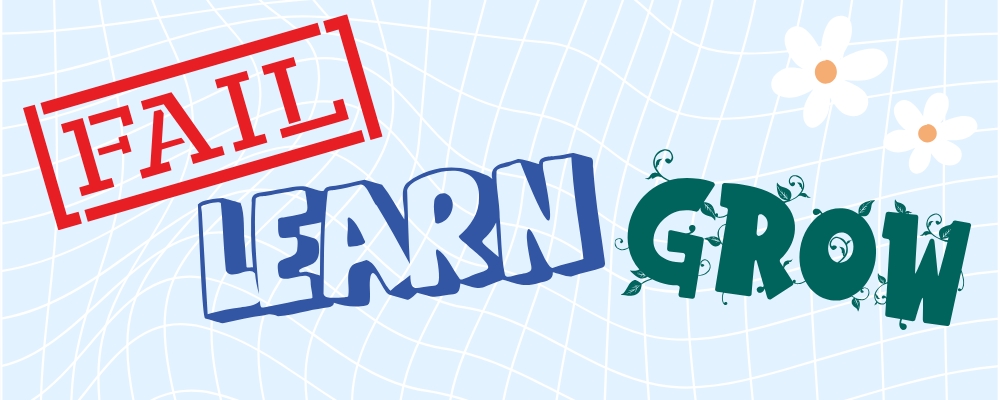How to Embrace the Right Kind of Failure in Your Organization
Jeremie Miller, May 16, 2025
As a team RAFT embraces the right kind of failures by using our #1 core vale: Fail. Learn. Grow. This is a process we follow when something goes wrong, or, more importantly when we want to experiment and try something new. It means a team member, or the entire team can take risks and get things wrong without the fear of punishment. This allows RAFT to explore ideas and possibilities, knowing that it doesn't have to work, not even a little bit. "Fail. Learn. Grow." gives the team permission to take risks, fail, and continue moving forward.
When I share this idea with leaders, they often share concerns like, "I can't allow my team make mistakes, it would put our clients, staff, and funding at risk."
This is a valid point, and I hope that this post will show you that this doesn't have to be true. Any organization can embrace the right kind of failures by understanding why having a positive culture of failure is healthy for your organization, the different types of failures, and by following a process to make sure your organization benefits from failures instead of increasing risks.
You want a positive culture of failure in your organization
Before we jump into the what and how of failure and using "Fail. Learn. Grow." it is important to understand why cultivating a positive culture of failure matters.
In her book "Right Kind of Wrong: The Science of Failing Well" Amy Edmondson's original research focused on hospital teamwork. She expected to find that the fewer mistakes a team made the better they performed. She was shocked to discover that the best teams in the hospital setting actually had higher, not lower error rates. Further research revealed that high-performing teams:
- View failures as stepping stones to new discoveries and success
- Foster openness, allowing team members to speak up and be open and honest about mistakes
- Don't make more mistakes than other teams, they just report more mistakes due to their willingness to be transparent (You can read more about the benefits of transparency here: https://www.raftcares.org/resources/community-blog/how-leaders-use-transparency/)
This research reveals that if you don't have a positive culture of failure, you still have mistakes happening, you just don't know about all of them. Being more open to failure as a method for learning, instead of something to be punished, will strengthen your organization.
Other benefits include:
- People feel heard when they can openly talk about mistakes and experiment with new ideas.
- Everyone having the opportunity to lead and innovate, even without formal leadership roles.
- Discovering new insights about your organization you would miss out on without experimentation.
- Breaking the need for perfection which is holding people back from productivity and innovation.
- Improving systems, policies, and processes
All these benefits will strengthen your organization. In fact, our RAFT "Road to Advocate Wellness" survey shows this approach can even reduce staff turnover, as advocates are seeking this kind of supportive work environment.
Now that you understand the "why" of embracing the right kind of failure in your organization let's explore the different types of failures and how to apply the "Fail. Learn. Grow." cycle.

The different types of failures
Amy Edmondson outlines three types of failures:
Complex failures: these result from multiple factors, often including uncontrollable external events. COVID-19, natural disasters, Trump winning the election are all events that lead to complex failures.
Basic failures: these are avoidable occurring in familiar territory and are mostly caused by inadequate training, coaching, systems, policies, and resources. Examples include Incomplete court paperwork, using personal vehicles for client transport, or missing a grant deadline.
Intelligent failures: these are productive, controlled failures necessary for progress and change. Intelligent failures provide you with valuable new information that can't be discovered any other way. For example, testing a new shelter intake process (while having the old system as a backup), or changing a policy on supply room access are experiments that could lead to success, or be an intelligent failure.
Complex failures are beyond what we will talk about in this post, but RAFT uses the "Fail. Learn. Grow." process to deal with both basic and intelligent failures.
A deeper look at basic failures
When a team member makes a mistake that is part of regular operations and is something that they should know how to do, you have experienced a basic failure. These are frustrating situations, and it can be easy to quickly assign blame.
However, Edmondson's research reveals that only about 1-2% of basic failures are blameworthy and rest solely on the shoulders of the person who made the mistake. In 98-99% of the cases people analyzing a basic failure realize that better onboarding and training, improved resources, coaching, better scheduling, or more focus on staff well-being could have prevented the basic failure occurring.
This is eye opening and shows that when a basic failure does occur the first place you need to look isn't the individual, but your organizational systems and supports.
AND, if your organization can LEARN from the basic failure, then there can still be a positive outcome. This is where the process of "Fail. Learn. Grow." can help.
Failing, learning, and growing after a basic failure
"Fail. Learn. Grow." helps the RAFT team avoid pointing fingers by examining all the factors contributing to the mistake, so we can focus on improvement:
Fail - the team member(s) reports the mistake without blame or fear of punishment.
Learn - hold a one-on-one or team meeting to discuss details and analyze the failure and how it can be prevented in the future.
Grow - create and implement a solution to prevent the mistake from reoccurring.
Repeat - if the same mistake is made again, the "Learn. Grow." steps didn't work and some tough conversations may need to happen. BUT if a new mistake is made then we return to the "Fail. Learn. Grow." process and come up with new ideas and a new plan.
A deeper look at intelligent failures
This is where the true power (and fun) of failing happens. You can theorize about new ideas and changes in your organization endlessly, but often, you aren't going to find out if something works until you give it a try. When you do give the idea a try it may be an astounding success, OR it may result in an intelligent failure.
Amy Edmondson provides guidelines to help identify potential intelligent failures:
- The failure explores unknown territory with uncertain outcomes.
- There is a credible opportunity to bring change or advance a desired goal.
- Your decision to experiment is informed by available knowledge.
- You can manage risks and minimize potential harm.
- You use the failure's outcomes to learn and guide next steps.
Organizations can feel a lot of frustration when stuck in a "we do it this way because we've always done it this way" rut. Advocates have exciting ideas they would like to try out and can feel ignored when leadership turns them down. The recent government grant freezes have shown that the old ways of funding aren't working, and new answers need to be discovered.
Old processes that don't really work, new ideas that could work, and finding new sources of funding are all perfect examples of how intelligent failures and the "Fail. Learn. Grow." process can benefit your organization.
Failing, learning, and growing is messy
Full transparency: RAFT isn't perfect at this, and we are still in the process of failing, learning, and growing on how to best use "Fail. Learn. Grow." Sometimes we do a great job of running the experiment and failing then get busy and forget the learn and grow parts. Other times we run the experiment, debrief and learn from the experiment, but move on to new ideas before trying again and growing.
But that is part of the whole learning and growing process, and as we have improved our "Fail. Learn. Grow." cycle over time I think a clearer process has developed that can help you skip over some of the bumps in the road the RAFT team has experienced.
How RAFT fails, learns, and grows with intelligent failures
Here is RAFT's current process for "Fail. Learn. Grow." (We don't follow this process formally all the time, but it is running through our heads)
- We acknowledge that we are going to try something new.
- We admit that this new thing may fail, and that is 100% ok.
- We decide if the possibility of failure is worth the risk.
- We limit the risk of the failure by running a pilot program.
- We decide on a set amount of time to run the experiment.
- After the set amount of time has passed, we debrief and identify what worked and what failed.
- We discuss and plan for moving forward with our new knowledge (or decide it is no longer worth heading in this new direction).

Debriefing is the key to learning and growing
Full transparency, again: our debrief process hasn't been the best in the past and has had a lot of iterations as we iron out the kinks. Our current debrief process, which we also teach in our urgency workshop, focuses on using a positive, strengths-based approach to study mistakes and look for improvements to be made in the future.
Here are RAFT's current debrief questions for analyzing an intelligent failure:
- Provide a summary of what happened with as much detail as possible.
- What would you like to happen in this situation? What is the ideal result?
- How can RAFT respond to this failure to achieve the ideal result?
- What could we do differently next time to achieve the ideal result in this situation? Think about:
- What strengths could we use?
- What actions could we take?
- What systems need to be added or changed?
- What resources are needed?
- What communication additions or changes could we make?
- Is there anything else we can do to achieve the ideal result next time?
- What impact would this new way of doing things, and the ideal result have on RAFT?
- What are our next steps in moving forward with this?
Getting started with the "Fail. Learn. Grow." Cycle
Now you have the why, what, and how of using "Fail. Learn. Grow." Depending on organization's current state, it may take some time for your team to feel comfortable sharing basic failures they have made with leadership. You may need to start building some psychological safety in your organization (a topic for another blog post).
However, you can start using "Fail. Learn. Grow." and building some of this psychological safety by starting with intelligent failures and running an experiment to test a new idea in your organization. Because you plan for intelligent failures to happen, and make it clear that they are low risk, and no one can get in trouble intelligent failure experiments are a great place to start.
So, find an idea (bonus points if it isn't your idea), set up a pilot program using the steps in this post, and start failing!








